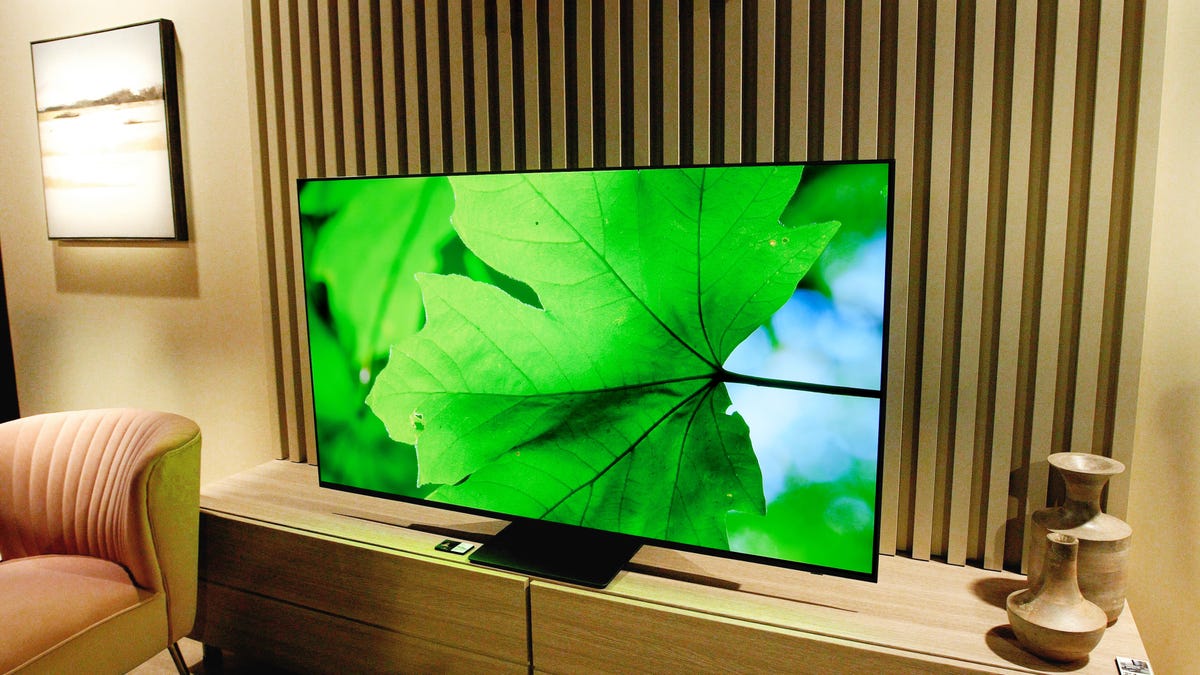 Why You Can Trust CNET
Why You Can Trust CNET Samsung OLED TV First Look: Why It Will Probably Beat Samsung's Own QLED TVs
Samsung's new QD-OLED TV could be its best big screen yet, and I just saw it in person for the first time.

Samsung's S95B OLED TV, in the flesh.
It took a while but Samsung's OLED TV is official, and at a press preview in New York I finally got to see it in person. The Korean electronics giant, which has been No. 1 in TV market share worldwide for more than a decade, finally announced the elusive television earlier in March with a name, price and release date.
The S95B series will come in a 55-inch size for $2,200 and a 65-inch size for $3,000, and it is available for preorder now to ship later in April. OLED TVs currently deliver the best picture quality available, and Samsung's OLED TV could be its best yet -- and will likely outperform the company's own QLED models.
Unlike Sony's QD-OLED press preview, which featured engineers, a reference monitor and a standard OLED TV for side-by-side comparisons, Samsung's presentation of the S95B was pure "lifestyle." I encountered the television in a faux living room environment at Samsung's New York City showroom, the screen showing pretty demo footage with no other TV nearby. Unfortunately I can't really say anything substantial about the picture quality. I mean sure, it looked really good with punchy colors and a nice bright image, and from off-angle it didn't get substantially worse (as every LCD-based TV does, including QLED models). But Samsung's demo didn't reveal much more, and so I'll have to wait for a real review sample in CNET's lab to see how it stands up to the competition.
I can talk about what I expect, however. The S95B uses an all-new QD-OLED panel, which promises improved color, brightness and viewing angles compared with standard OLED TVs. The new panel technology could mean a new king of TV picture quality, but as always in the TV world, competition is stiff. First off, Sony's own QD-OLED TV, the A95K, looks pretty impressive. Then there's LG, which has been selling OLED TVs for the last few years and has new models of its own, using standard OLED panels and promising better brightness than ever.
I haven't reviewed any of these TVs yet but from what I've seen so far from Sony and LG, Samsung's S95B has its work cut out for it. Current OLED TV image quality is already so good that it might be difficult to convince high-end buyers to pay extra for QD's special sauce. LG has priced its new C2 models -- which are also available in a much wider variety of sizes than QD-OLED TVs, starting at 42 and going up to 83 inches -- hundreds of dollars less than the Samsung OLED TV, while LG's step-up 55- and 65-inch G2 OLED TVs, which promise better brightness, match Samsung's pricing.
OLED vs. QLED TVs
Samsung also makes a dizzying variety of non-OLED TVs under its QLED brand, and they're very different from OLED. If past experience is any indication, Samsung's QD-OLED TV will deliver better overall picture quality than any of its QLED models. Yes, QLED TVs like the QN90A can get brighter than OLED, but in other areas that matter, such as contrast, color, uniformity and viewing angle, OLED TVs have always outperformed QLED TVs, which are based on LED and Mini-LED backlight technology.
OLED and QD-OLED are different because they don't use an LED backlight to produce light. Instead, light is produced by millions of individual OLED subpixels. The pixels themselves -- tiny dots that compose the image -- emit light, which is why it's called an "emissive" display technology. That difference leads to all kinds of picture quality effects, some of which favor LCD (and QLED), but most of which favor OLED.
In this photo provided by Samsung, the S95B looks a bit bigger than 65 inches, its true largest size.
And then there's the question of naming. In announcing the QD-OLED tech at CES, sister company Samsung Display called it a "QD Display," but the official name is simpler. "Since the term OLED is already widely accepted and understood, Samsung decided to go with the nomenclature 'Samsung OLED TV' to avoid confusion among consumers," a Samsung representative said.
It will be fascinating to see how TV shoppers respond to all the new choices, and I'm looking forward to checking out the new TVs soon.

